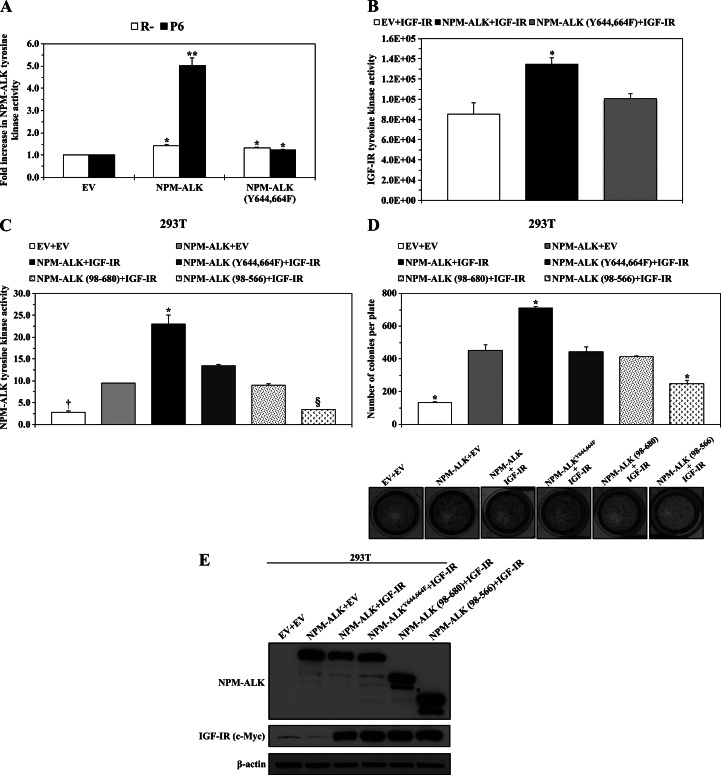Figure 3.
NPM-ALKY644,664F demonstrates significantly decreased interactions with IGF-IR. (A) Transfection of WT NPM-ALK or NPM-ALKY644,664F in R- cells that lack expression of IGF-IR was associated with a relatively small but statistically significant increase in NPM-ALK tyrosine kinase activity. Similarly, there was a slight increase in tyrosine kinase activity when NPM-ALKY644,664F was transfected into P6 cells that express IGF-IR. Notably, NPM-ALK tyrosine kinase activity was much more pronounced when WT NPM-ALK was transfected into P6 cells. The results are shown as means ± SE of three different experiments (*P < .05, **P < .01). (B) Measuring IGF-IR tyrosine kinase activity by using in vitro translated WT NPM-ALK or NPM-ALKY644,664F as a direct substrate of IGF-IR shows that IGF-IR tyrosine kinase activity significantly increased compared to the baseline level only when WT NPM-ALK was used as a substrate. IGF-IR tyrosine kinase activity is depicted as luciferase activity (in relative light unit). The results are shown as means ± SE of three experiments (*P < .05 compared with other experimental conditions). (C) Transfection of WT NPM-ALK or different functionally defective constructs with IGF-IR in 293T cells showed that WT NPM-ALK possesses significantly greater tyrosine kinase activity when transfected with IGF-IR compared to WT NPM-ALK transfected with EV or compared to NPM-ALKY644,664F, NPM-ALK (98–680), or NPM-ALK (98–566) transfected with IGF-IR. The tyrosine kinase activity of NPM-ALKY644,664F transfected with IGF-IR was similar to WT NPM-ALK transfected with EV and higher than that of the mutants NPM-ALK (98–680) and NPM-ALK (98–566) transfected with IGF-IR. The results are shown as means ± SE of three experiments (*P < .01 versus all other experimental conditions, †P < .01 versus all except NPM-ALK (98–566) + IGF-IR, §P < .01 versus all except EV + EV). (D) Transfection of WT NPM-ALK and IGF-IR into 293T cells was associated with a significantly higher anchorage-independent colony formation potential when compared with all other conditions. Transfection of EV and WT NPM-ALK or of IGF-IR and NPM-ALKY644,664F or NPM-ALK (98–680) resulted in a significantly higher number of colonies than transfection of EV only or of IGF-IR and NPM-ALK (98–566). The results are shown as means ± SE of three experiments (*P < .01 versus all other experimental conditions). (E) The expression levels of IGF-IR and the different NPM-ALK constructs in 293T cells after transfection. β-Actin demonstrates equal loading of the different proteins.

